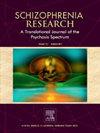美国西班牙裔精神分裂症患者社会认知测量的心理计量学验证
IF 3.5
2区 医学
Q1 PSYCHIATRY
引用次数: 0
摘要
在像西班牙裔这样占美国人口很大一部分的少数族裔群体中,人们对社会认知测量的跨种族差异知之甚少,这可能导致文化不一致的干预。使用社会认知心理测量评估(SCOPE)的数据,本研究对诊断为精神分裂症的西班牙裔(n = 73)和非西班牙裔白人(n = 115)进行了四项社会认知测量的跨种族心理测量评估。任务包括Bell Lysaker情绪识别任务(BLERT)、Penn情绪识别任务(ER-40)、社会推理意识测试(TASIT)和暗示任务。对任务进行测试-重测信度、作为重复测量的效用、内部一致性、对组差异的敏感性以及与功能结果的关系评估。还分析了族群间的平均差异。心理测量特性在很大程度上是足够的,并且在不同种族之间具有可比性。情绪识别任务的平均差异在种族间无显著差异。然而,西班牙裔在TASIT和暗示任务(心理理论评估)上的得分明显较低,这可能表明种族或文化因素在这些措施中的影响。标准效度在各组之间也有差异。尽管在西班牙裔群体中,功能能力和社交技能有很强的相关性,但没有一项社会认知任务能预测这一群体在现实世界中的功能结果。这些发现表明,在使用社会认知测量来评估西班牙裔和做出后续临床决策时应谨慎行事。本文章由计算机程序翻译,如有差异,请以英文原文为准。
Psychometric validation of social cognition measures in U.S. Hispanic individuals with schizophrenia
Little is known about cross-ethnic differences in the measurement of social cognition in minoritized groups like Hispanics, who account for a significant portion of the U.S population, potentially leading to culturally incongruent interventions. Using data from the Social Cognition Psychometric Evaluation (SCOPE), the current study conducted a cross-ethnic psychometric assessment of four social cognition measures in Hispanics diagnosed with schizophrenia (n = 73) and a non-Hispanic white group (n = 115). Tasks included Bell Lysaker Emotion Recognition Task (BLERT), Penn Emotion Recognition Task (ER-40), The Awareness of Social Inference Test (TASIT) and the Hinting Task. Tasks were evaluated on test-retest reliability, utility as a repeated measure, internal consistency, sensitivity to group differences, and relationship to functional outcomes. Mean differences between ethnic groups were also analyzed. Psychometric properties were largely adequate and comparable across ethnic groups. Mean differences on emotion recognition tasks were not significantly different between ethnic groups. However, Hispanics scored significantly lower on TASIT and the Hinting Task (assessments of theory of mind), potentially indicative of the influence of racial or cultural factors in these measures. Criterion validity also varied between groups. Although there were robust associations with functional capacity and social skills in the Hispanic group, none of the social-cognitive tasks predicted real-world functional outcomes in this group. These findings suggest that caution should be exercised when using social cognition measures to assess Hispanics and making subsequent clinical decisions.
求助全文
通过发布文献求助,成功后即可免费获取论文全文。
去求助
来源期刊

Schizophrenia Research
医学-精神病学
CiteScore
7.50
自引率
8.90%
发文量
429
审稿时长
10.2 weeks
期刊介绍:
As official journal of the Schizophrenia International Research Society (SIRS) Schizophrenia Research is THE journal of choice for international researchers and clinicians to share their work with the global schizophrenia research community. More than 6000 institutes have online or print (or both) access to this journal - the largest specialist journal in the field, with the largest readership!
Schizophrenia Research''s time to first decision is as fast as 6 weeks and its publishing speed is as fast as 4 weeks until online publication (corrected proof/Article in Press) after acceptance and 14 weeks from acceptance until publication in a printed issue.
The journal publishes novel papers that really contribute to understanding the biology and treatment of schizophrenic disorders; Schizophrenia Research brings together biological, clinical and psychological research in order to stimulate the synthesis of findings from all disciplines involved in improving patient outcomes in schizophrenia.
 求助内容:
求助内容: 应助结果提醒方式:
应助结果提醒方式:


